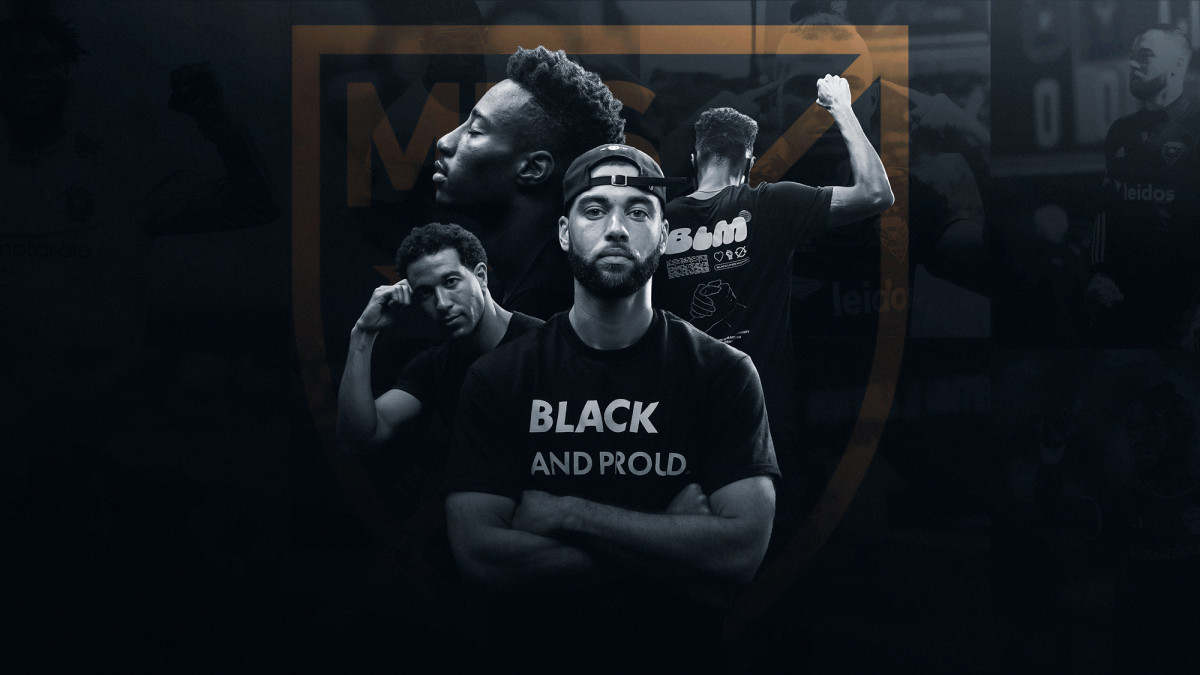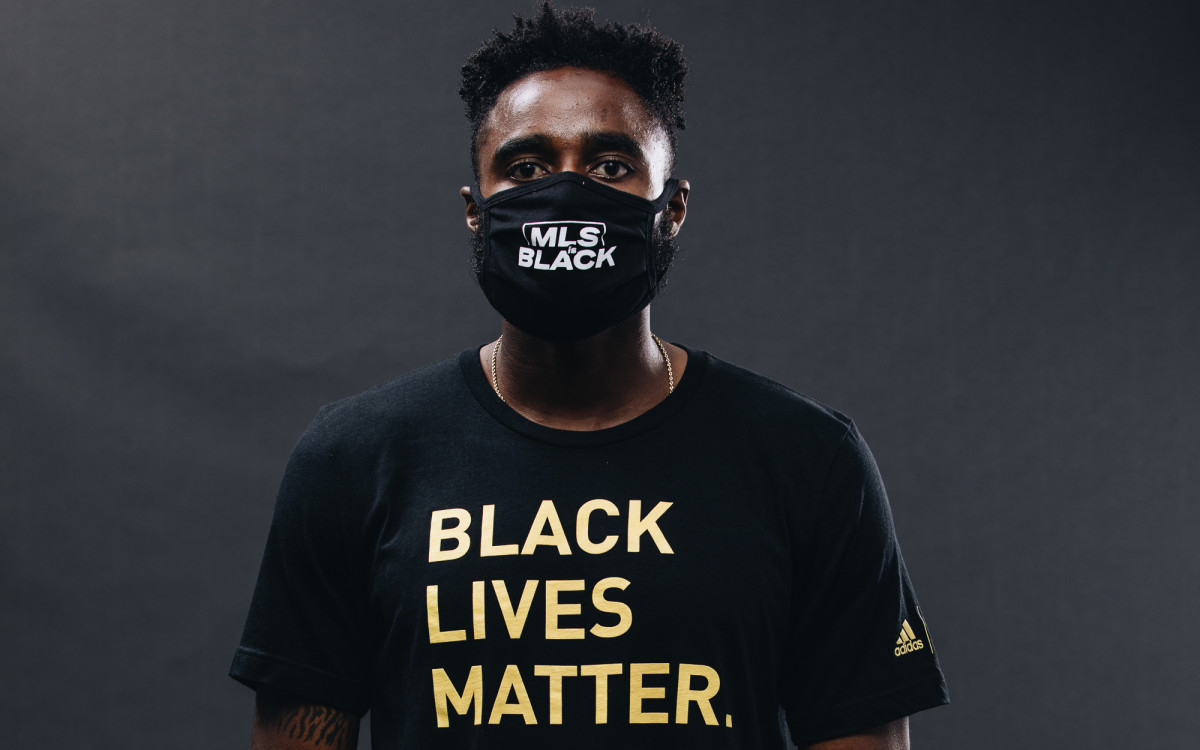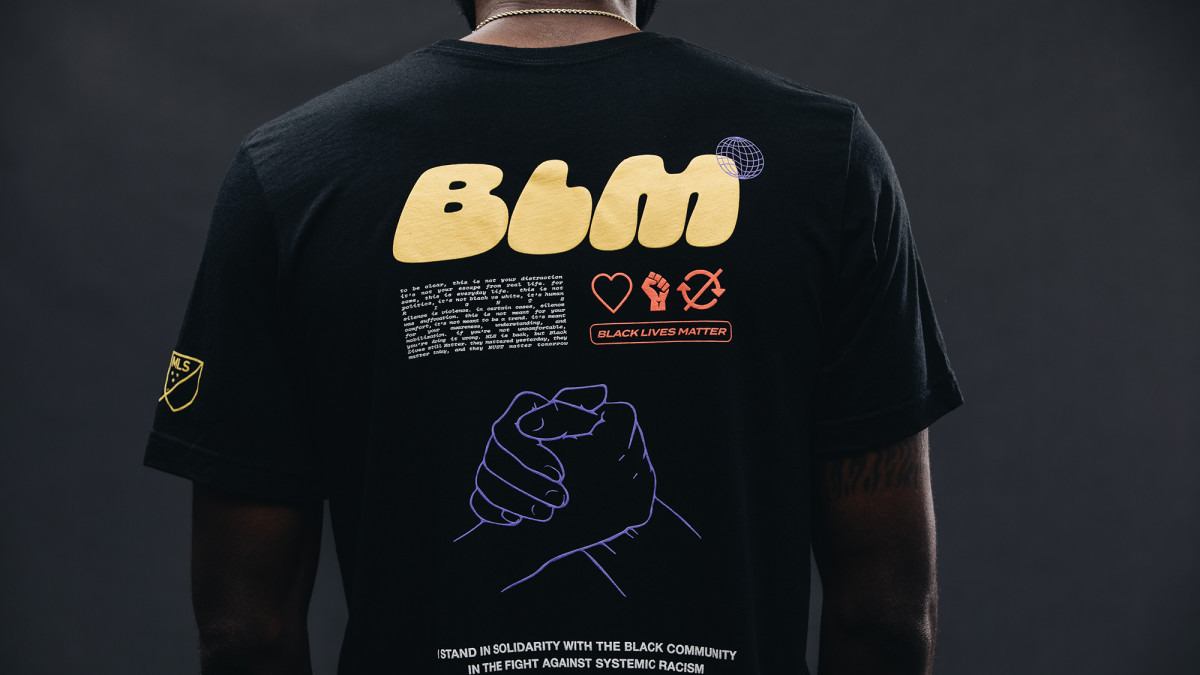MLS's Black Players for Change Are Just Getting Started
The memory of the moment remains so vivid.
It was July 8, inside ESPN’s Wide World of Sports Complex at Disney World. MLS was moments away from resuming its season, with Orlando City about to kick off against Inter Miami to begin the MLS Is Back tournament. Amid a pandemic and a national battle against social injustice, more soccer was returning in North America, following the start of the NWSL Challenge Cup. There was excitement, but there was also apprehension. From players, coaches and fans, no one knew what to expect.
And then it happened.
Orlando and Miami players stood outside the center circle as the officials entered the pitch. The camera opened, and behind them was a sea of players surrounding both teams. Black players. Black athletes. All in a line, united and together, wearing black gloves, masks and black T-shirts with different messages.
SILENCE IS VIOLENCE.
BLACK AND PROUD.
BLACK ALL THE TIME.
They raised their right fists in the air, in complete silence, as Orlando and Inter Miami kneeled in the middle. The camera widened even more, and more black players entered the frame, all around the pitch. It was more than a hundred. Silent, in self-contemplation.
There was no noise or commentary. It lasted for eight minutes and 46 seconds, a tribute to George Floyd, who was killed by Minneapolis policeman Derek Chauvin kneeling on his neck for that extended period of time. But it transcended into more than that. It was an opportunity for all who were watching to do something that perhaps has been missing these last few months. It was a time to reflect, look within and ask, "What are we doing? Is this who we want to be?"
What an incredibly powerful pregame display from @BPCMLS #MLSisBack #MLSisBlack
— SI Soccer (@si_soccer) July 9, 2020
(via @MLS) pic.twitter.com/JO4UxJs3VR
It was a compelling, powerful moment. A demonstration of unity, strength and resilience marking the official arrival of MLS's Black Players for Change (formerly known as the Black Players Coalition but changed after a conversation and alliance with the Players Coalition, the NFL group founded by Anquan Boldin and Malcolm Jenkins).
Now, nearly a month later, BPC—with more than 70 members, newly formed alliances and a clear mission—continues its work beyond that scene in July. Because as powerful and impactful as the scene was, it was but one moment. What BPC wants now is continued and sustained action. After the compelling moments, after the calls for unity and social justice, after the yearning for equality, BPC’s biggest, most important fight is to fundamentally change the culture of the game in America for black soccer players.
As MLS's tournament in Orlando reaches its conclusion, and the battle against injustice rages on, what is next for this intrepid group?
**********

Justin Morrow is not going to lie. He's tired. He’s often overwhelmed, and as far as the 32-year-old Toronto FC veteran is concerned, this year has been nothing short of intense.
“These past few months have been crazy. Someone asked me the other day to add another thing on to my plate, on top of my professional career and being a leader in Black Players for Change, and I just told them I can’t do any more than what I am doing right now,” says Morrow, who is a cofounder and executive director of the organization. “But also, these last few months have been some of the most memorable of my whole life and what I am doing at this moment I will look back on very fondly, so I must lean into it. The formation of BPC has been life-changing for me, and I believe for the members of our group as well. So, we are completely in this moment.”
This moment is now a plan.
Working closely with commissioner Don Garber, technical directors and chief soccer officers from all of the league's 26 clubs, Morrow and his team have been in constant conversation with MLS in order to achieve key, specific objectives.
“We came together as a group of black players in Major League Soccer, so the change we’re looking to make starts specifically within MLS,” Morrow says. “So, we have that, but we also have an initiative where we want to help in our local communities to address systemic racism. Within MLS, it [the plan] has been well received, not only from our peers but from the league as well. In the end, Black Players for Change was formed so we can hold the league accountable for all the things they say they’re going to do so we can follow up with statements and social media posts after the fact.”
Accountability, as Morrow mentioned, is the first part, and it begins with hiring in specific roles. According to an upcoming report on Black and Latinx representation in U.S. Soccer for FARE (Football Against Racism in Europe), composed by Brenda Elsey (Hofstra University) and Jermaine Scott (Florida Atlantic University), the lack of Black representation in coaching and executive roles across the league is overwhelming.
“This [lack of representation] contrasts with the contributions of Black players, who make up a significant percentage of the rosters,” Elsey says. “For example, while Black players make up about 25% of players in the league, they comprise less than 2% of executives. We see a juggernaut that excludes Black, Latinx and women from taking part in steering the ship.”
The report also highlights obvious factor—the lack of Black coaches (only two: Montreal Impact’s Thierry Henry and Colorado Rapids' Robin Fraser), zero Black majority owners and only two Black general managers (Toronto FC's Ali Curtis and New York Red Bulls' Denis Hamlett).
This is something Morrow wants to change with key ideas that begin with a chief diversity officer that creates a culture of accountability.
“We are talking about changing Black representation at all levels, and when you look at the highest level, a chief diversity officer will go a long way towards increasing the Black representation that we want to see, so that’s paramount," Morrow says. "But then when we talk about culture education and implicit bias training, these are important for people who are in hiring positions to understand where their own bias might take part in who they hire. We’ve seen in the recent past that MLS has had positions open and who they’re considering, and we want to make sure that everyone has a chance equally, and that our Black and minority coaches are getting a chance to be interviewed—and not only be interviewed but also having fair chances in that interview.”
A few good men chasing a HIGHER PURPOSE 👊🏾 pic.twitter.com/TjpxDzGIeS
— Darlington Nagbe (@darlingtonnagbe) August 5, 2020
The second part takes place on the field, where the goal is to create mentorship programs for young academy Black and minority players, especially those on the cusp of signing homegrown contracts.
“It’s very important that we have some type of mentorship program that allows these young Black boys and girls that are playing our sport now to have a relationship with a current professional, knowing that there’s a pathway for them to become on the first team and to be successful,” Morrow said. “We want to be able to nurture those relationships and give them someone that they can look up to in a real personable way, knowing that they can relate to those issues that they’re dealing with off the field with someone that looks exactly like them, which they might not always get.”
As MLS recently announced the creation of an expansive youth development platform, which includes more than 100 academies from multiple tiers across U.S. soccer, this mentorship program could prove to be an asset toward Black player development, but the efforts don’t end there. The need to be trained, guided and scouted by Black coaches from all over the country is another important piece of the puzzle.
“One thing we have in place is also working with Black academy coaches as this new academy league is starting,” says D.C. United goalkeeper Earl Edwards Jr., a board and principal member of BPC and one of the most influential voices inside the organization. “It’s going to be a great way for us to connect with them and start putting ideas together and support the Black kids in our country and make sure they’re getting recognized, but from the very base of it is being seen and having a chance. I think due to the pay-to-play system, we have so many overlooked Black players, because they just can’t afford it and not having the opportunity to showcase what they’re capable of.”
From a more personal standpoint, Edwards wants to also implement an initiative that helps Black players who are nearing the end of their careers and have programs available that offer MLS-related opportunities once they retire from playing.
“Hopefully we get it done in time, so personally I can take advantage of that and be a part of it and see how these programs can help Black people moving forward,” he said.

There is also the need to improve connections with local communities to not just create a stronger bridge between club and city, but also to open the doors for an inviting, equality-driven environment that serves as a tool for social development. This is something that hits so close to home for the Philadelphia Union’s Warren Creavalle, who does a tremendous amount with young people in Chester, Penn., where the club plays.
“Young people are the seeds that are going to shape what the future looks like,” says the 29-year-old, who represents Guyana internationally (he was born in Brooklyn, but his father is from Guyana and his mother from Grenada.) “To have [local youth] as informed and confident as possible, and as well-equipped, providing them with access with things we may not have had when we were young, I think that can drastically change the landscape of what the nation could look like in the future.”
Much like his BPC peers, Creavalle has been incredibly busy. In addition to playing a role in the Philadelphia Union's run to the MLS Is Back semifinals, which ended in Wednesday's 2-1 defeat to the Portland Timbers, his work with MLS toward Black Lives Matter awareness has not gone unnoticed. As a passionate clothing designer, he was selected by the league to create designs and a T-shirt for the tournament, to stand in solidarity with the Black Lives Matter movement and stand with victims of police brutality. The shirts have been worn by players, coaches and staff throughout the competition in Orlando. The front reads "Black Lives Matter" in gold lettering, and on the back, there is a statement inspired by a blog post from Timbers forward Jeremy Ebobisse.
MLS recently announced that all profits will be donated by the league to the NAACP Legal Defense Fund, 100 Black Men of America, and the Player’s Coalition in partnership with BPC.

This concept was part of the work Creavelle does with Chester’s young community, as he is part of Design FC, an after-school program with mainly fifth- and sixth-graders that fosters creative thinking and design. He feels a tremendous sense of pride that his BLM design was essentially born from this program and the work he does with these students.
“Week in and week out, for them to be able to see something that I have created, somebody that they see on a weekly basis, that they have a personal relationship with, I think it makes it that much more tangible. And for me, to see that and have that perspective, that’s one of the biggest things for me. And I think that can be said for any Black kid in the neighborhood.”
**********
Black Players for Change is not a naive organization. The members know these initiatives will not be achieved overnight, nor will they come without hurdles. But this movement isn’t a spark that quickly fades away. It’s a forest where trees are planted so the fruits of their labor can be relished in the future.
“I think the reason all of us are doing anything regarding racial injustice and these issues is so that the following generations don’t have to the same things we did,” Edwards says. “And that’s the reason we are fighting these battles. Yes, of course, it’s also for us personally, but more so there’s progress, so there’s a better life for those to come. So, while we’re working with the coaches to put this process in place, the ultimate goal is that the next generation has it better than I did, better than we did growing up. It’s why we’re all here and doing it in the first place.”
This journey for social equality has no time limit. As the late legendary civil rights leader John Lewis once said, the fight and struggle are not “of one day, one week, or one year ... it is the struggle of a lifetime, or maybe even many lifetimes, and each one of us in every generation must do our part."
So, a final question must be asked. Is there a worry that the support will eventually die down? Or is there fortified hope that this time around, there really will be change?
“Both,” says Morrow. “I worry because I have seen time and again the cycle of violence played out in North America, where a Black person is killed at the hands of a white person, and there’s initial outrage and it dies down. But I’m hopeful that this time will be different, because I have seen the reaction of not only my Black peers in the community, but my peers of all different races, as well. You’ve seen how many people have taken to the streets, and really my hope is that this organization Black Players for Change can really act towards the fact that we will be around forever. We will be the organization that holds MLS’s feet to the fire in the sense that we want to see change, we will make change and we won’t go away.”
